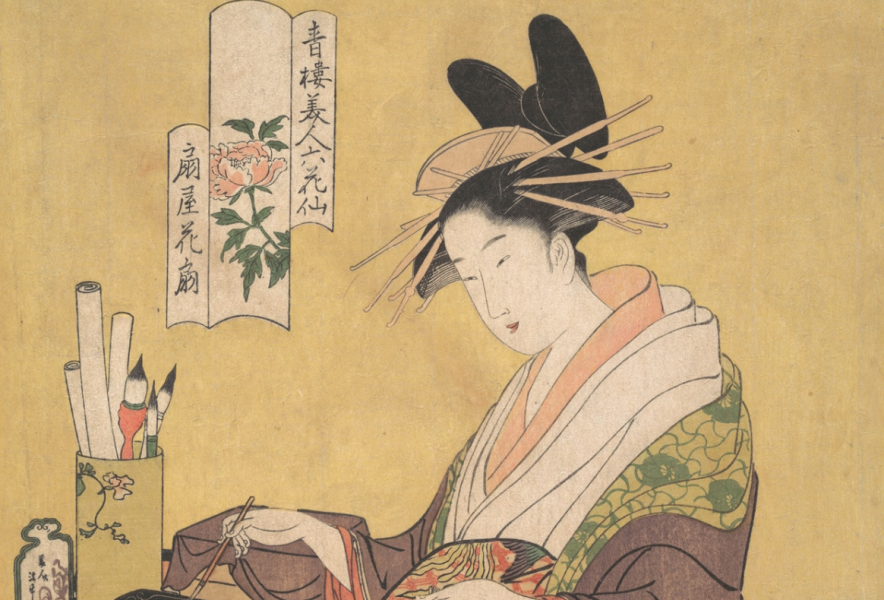Yoshiwara, famous for its ‘yukaku’, developed in the 17th century as a meeting place for yujo(遊女) and flourished as a pleasure quarter over the centuries from the Edo period to the Meiji era.
The origins of the yukaku date back to the reign of Toyotomi Hideyoshi, who, from 1585, built places for prostitutes in Osaka and then Kyoto.
.jpg)
In this unobstructed view, courtesans are entertaining customers with music, dance, food, and drink,Hishikawa Moronobu, 1680 (image from Metropolitan Museum)
This policy was continued by the Tokugawa regime, which in 1617 authorised the construction of a ‘Keisei-machi’ (a brothel) in ‘Fukiya-machi’ (near present-day Nihonbashi Ningyocho, Chuo-ku), bringing together brothels scattered in several locations throughout Edo.
The ‘Yoshiwara yukaku’ continued to exist through the end of the Edo period and into the Showa period, even after it was relocated to Asakusa’s Shin-Yoshiwara in 1657.
The yujo had ranks⁈
The term ‘yujo’ refers to women engaged in sexual services in general, but yujo were also known as tayu(太夫) or oiran (花魁), depending on their rank.
The ranks of prostitutes were divided and named differently depending on the era, but they mainly started as apprentices in the Kamuro(禿) rank, made their debut as Shinzo(新造), and worked their way up through Hashijoro(端女郎), Kakoi(囲), Oshoku(御職) and Koshi(格子) to Tayu.
-scaled.jpg)
Yoshiwara Picture Book of New Year’s Festivities, Kitagawa Utamaro,1804 (image from Metropolitan Museum)
See also Why Ukiyo-e is said it was a “Media”? How did people in Edo enjoy them?
Tayu was the highest rank of prostitute, and only a handful – between three and five out of a thousand – were allowed to claim the title.
To become a tayu, in addition to good looks, one had to possess a wide range of skills and knowledge. For example, some stories say that a tayu had to know famous waka poems by heart, or that the Tale of Genji was kept in the tatami room.
Yujo were also expected to have a good knowledge of culture and music. At the same time, the guests were expected to have appropriate manners, and it was not a place where you could enjoy yourself as long as you paid money. The “Tsu(通)” way to play was to behave smartly as a man, while respecting the status of the prostitutes.
Unique culture that has flourished
During the Edo period, the Yoshiwara yukaku was controlled by the shogunate, which had strict rules to prevent prostitutes from going out or escaping.
The yukaku was surrounded by a wall, outside of which was a moat more than 5 metres wide, known as the ‘o-haguro-dobu(お歯黒どぶ)’. Furthermore, there was only one entrance to the yukaku, which was surrounded by walls on all sides.
It was within such a brothel that a unique culture blossomed.
The parade of beautiful yujo through Yoshiwara, as performed in films and plays, was called ‘Oiran-dochu(花魁道中)’. Only a limited number of women of high rank among the Yoshiwara yujo were allowed to perform the oiran-dochu. When summoned by a customer, these high-ranked courtesans would walk down the main street with a large number of attendants, dressed in luxurious and gorgeous costumes.
.jpg)
Yoshiwara Yo Zakura no Zu, Utagawa Hiroshige, Edo period (image from Metropolitan Museum)
In spring, rooted cherry trees were planted along the main street of Yoshiwara. After dark, beautifully dressed yujo parade under the cherry trees in full bloom, lit by snow lanterns. The bewitching beauty of the prostitutes was said to be out of this world.
The tragic love between yujo and customers was often the subject of novels and plays. Yoshiwara yujo were not allowed to leave Yoshiwara until the end of the year, or until they found a man who would pay them a large sum of money to take them in. It was therefore not uncommon for a yujo to fall in love with a customer.
.jpg)
The Courtesan Hanaōgi of the Ōgiya Brothel (Ōgiya Hanaōgi), from the series Beauties of the Pleasure Quarters as Six Floral Immortals (Seirō bijin rokkasen),Chōbunsai Eishi,1794 (image from Metropolitan Museum)
It’s not acceptable, but…
Although the Yoshiwara yukaku were closed by law in the Meiji era, their history and culture still attract many people as part of Japan’s heritage.
Prostitution is not permissible from the legal and human rights perspective of modern Japan, and there is no room for tolerance in modern society.
However, this feeling is based on a perspective born after the modern era, and we cannot condemn the people of the Edo period, or even earlier, based on our modern sensibilities.
It is also a fact that the yukaku of the Edo period, despite their sad history of peddling, had a deep relationship with the culture of the time as a form of entertainment on a par with theatre, and that the aesthetic of ‘iki(粋)’ was born around the brothel as a social space, constituting an important aspect of Edo culture.
See also Why Ukiyo-e is said it was a “Media”? How did people in Edo enjoy them?

